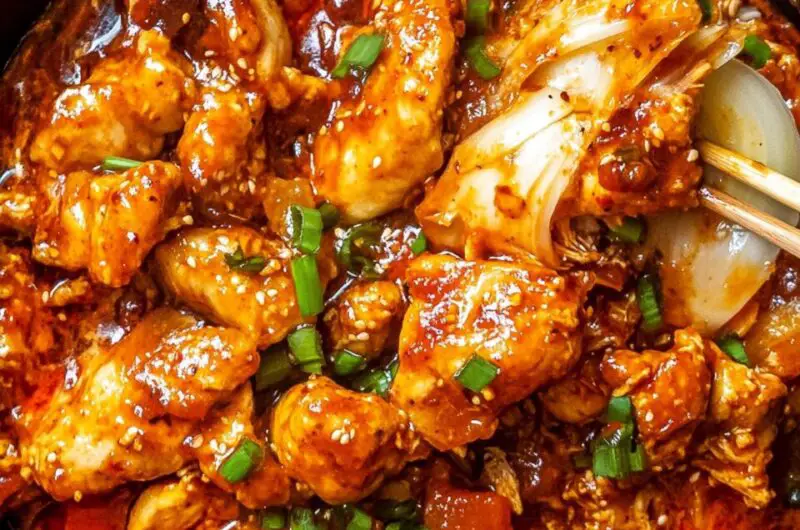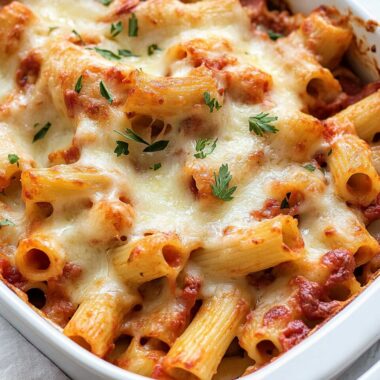Korean cuisine is known for its bold flavors, and Buldak, also known as “fire chicken,” is no exception. This dish has gained international recognition for its intense spiciness, deliciously marinated chicken, and the option to add gooey melted cheese on top. For spice lovers, Buldak is a must-try dish that not only satisfies cravings but also delivers a serious heat punch.
Full Recipe:
Ingredients:
-
1.5 pounds boneless, skinless chicken thighs, cut into bite-sized pieces
-
1/4 cup gochugaru (Korean red pepper flakes)
-
2 tablespoons gochujang (Korean red pepper paste)
-
2 tablespoons soy sauce
-
1 tablespoon sesame oil
-
1 tablespoon vegetable oil
-
2 tablespoons rice syrup (or honey)
-
4 cloves garlic, minced
-
1 teaspoon ginger, minced
-
1 cup rice cakes (tteok), optional
-
1 cup shredded mozzarella cheese, optional
-
2 green onions, chopped, for garnish
Directions:
-
In a large bowl, combine gochugaru, gochujang, soy sauce, sesame oil, vegetable oil, rice syrup, garlic, and ginger to create a spicy marinade.
-
Add the chicken pieces to the marinade, ensuring they are well-coated. Cover and refrigerate for at least 1 hour.
-
If using rice cakes, soak them in warm water for 10 minutes, then drain.
-
Heat a large, ovenproof skillet over medium heat. Add the marinated chicken (and rice cakes, if using) along with any remaining marinade. Cook, stirring occasionally, until the chicken is cooked through and the sauce has thickened, about 10-12 minutes.
-
If adding cheese, sprinkle the shredded mozzarella over the top of the chicken. Place the skillet under a broiler for 2-3 minutes, until the cheese is melted and bubbly.
-
Garnish with chopped green onions and serve hot.
Prep Time: 15 minutes | Cooking Time: 15 minutes | Total Time: 30 minutes
Kcal: 350 kcal | Servings: 4 servings
The Origins of Buldak
Buldak became popular in South Korea during the early 2000s when spicy food trends were booming. The word “Buldak” is derived from “bul” (meaning fire) and “dak” (meaning chicken). The dish was designed to be incredibly spicy, catering to the growing demand for tongue-tingling, sweat-inducing food. Many restaurants and street vendors in South Korea began serving different variations of Buldak, each offering a unique level of heat and flavor. It became a viral sensation, thanks to food challenges where people tested their spice tolerance by eating this fiery dish.
The Flavor Profile of Buldak
The primary characteristic of Buldak is its extreme heat, which comes from the combination of gochugaru (Korean red pepper flakes) and gochujang (Korean red pepper paste). These two ingredients provide a deep, smoky, and slightly sweet spice that sets the dish apart from other spicy chicken recipes.
Aside from heat, Buldak also carries a well-balanced umami flavor, thanks to the use of soy sauce, garlic, sesame oil, and a touch of sweetness from rice syrup or honey. Some variations include additional spices like black pepper and ginger to enhance the complexity of flavors. When cheese is added on top, it creates a creamy, slightly salty contrast that helps balance the spiciness, making the dish even more enjoyable.
Different Variations of Buldak
Over the years, Buldak has evolved, and many variations have emerged to cater to different taste preferences. Some of the most popular types include:
1. Cheese Buldak
One of the most well-loved versions, Cheese Buldak features a generous layer of melted mozzarella cheese on top of the spicy chicken. The cheese helps mellow the heat, creating a delightful combination of creamy and spicy flavors.
2. Ramen Buldak
This version incorporates spicy Buldak flavors into Korean ramen noodles. Brands like Samyang have created instant “Buldak Ramen” that mimic the heat and taste of the original dish, making it accessible to those who crave spice but prefer a noodle-based meal.
3. Honey Buldak
For those who enjoy a sweet and spicy contrast, Honey Buldak is a great option. It uses honey or additional rice syrup to balance out the spiciness, making the dish more tolerable for people who are not used to extreme heat.
4. Stir-Fried Buldak
Instead of broiling or baking the dish, some versions of Buldak are stir-fried with vegetables like onions, bell peppers, and scallions. This method adds extra texture and sweetness to the dish.
5. Buldak with Tteok (Rice Cakes)
Some people enjoy adding tteok (Korean rice cakes) to Buldak, creating a chewy texture that pairs well with the spicy sauce.
Best Ways to Serve Buldak
Buldak can be served in different ways, depending on how much spice and additional textures you prefer. Here are some of the best ways to enjoy this dish:
- With Steamed Rice: The most traditional way to eat Buldak is with a bowl of steamed white rice, which helps neutralize the spiciness and allows the flavors to shine.
- As a Wrap: Some people like to wrap Buldak in lettuce leaves to add freshness and crunch.
- With Pickled Radish: A common Korean side dish, danmuji (yellow pickled radish), is often served with Buldak to cleanse the palate and balance out the spice.
- With Noodles: Mixing the spicy chicken with chewy Korean noodles makes for a satisfying and flavorful meal.
Tips for Enjoying Buldak Without Overwhelming Spice
Since Buldak is notoriously spicy, here are some tips to enjoy it without feeling overwhelmed:
- Start with a Small Portion: If you’re not used to spicy food, take small bites and gradually increase your intake.
- Pair with Dairy: Drinking milk, eating cheese, or having yogurt on the side can help neutralize the burning sensation.
- Add More Sweetness: Increasing the amount of honey or rice syrup in the sauce can tone down the heat.
- Use Less Gochugaru and Gochujang: Adjusting the spice levels in the marinade will help control how spicy the dish becomes.
- Serve with Cooling Sides: Side dishes like cucumber salad or pickled radish can help refresh your palate between bites.
Why You Should Try Buldak
Buldak is not just a meal; it’s an experience. It tests your spice tolerance, excites your taste buds, and delivers a deeply satisfying umami flavor. It is also highly versatile you can enjoy it in various forms, whether as a comforting cheese-laden dish or a quick and spicy ramen bowl.
Beyond its taste, Buldak is also rich in protein, making it a great meal for those looking to include more protein in their diet. The use of fermented ingredients like gochujang also provides gut health benefits. Plus, it’s a fantastic dish to share with friends and family, especially if you enjoy spicy food challenges!
Conclusion:
Buldak is an iconic Korean dish that continues to gain popularity worldwide. Its combination of intense heat, deep umami flavors, and various customizable options makes it a favorite among food enthusiasts. Whether you try the classic version, the cheesy variation, or a milder honey-infused take, there’s a Buldak recipe for everyone.








